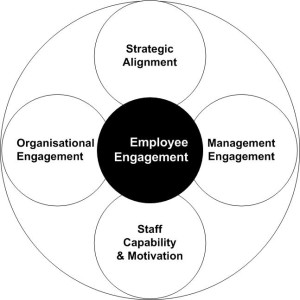Business has always been competitive. Failure to engage employees in digital transformation has significant consequences but engaging employees in digital transformation increases competitiveness.
Queensland University of Technology (QUT) runs a digital workshop with the theme:
“Tell me what business you’re in and your greatest strength and I’ll tell you how I’ll disrupt you.”
Some will be alarmed. Others want to learn how – now!
C-Suite decision making and contribution is challenged when assumptions based on experience no longer hold true. Forewarned is forearmed but having eyes ‘that do not see’ and ears ‘that do not hear’ is no excuse for becoming the victim. Unfortunately, C-Suite failings can become consequences for all staff.
The dual challenges of digital transformation and employee engagement make decision making in the C Suite tougher but quitters never win and winners never quit. Leveraging the benefits of digital transformation is an acquired skill. Knowing how is increasingly vital skill for members of the C Suite.
Digital Transformation
Digital transformation uses technology and automation to enhance traditional business models.
The result is more effectively engaging customers at every ‘moment of truth’ or touchpoint based on a formal renovation and recreation of the business vision, objectives, model and resources.
Digital transformation re-architects, reconfigures and creates synergy to protect and grow margin and develop innovative revenue sources.
Examples include increasing traditional revenue through digital channels, responding positively to the power of the empowered digital customer, a start-up quickly taking a large market share of a traditional market or improving return on investment by adding value along the entire value stream.
Employee Engagement
Employee engagement is a measure of the extent to which employees feel passionate about their jobs, are committed to the organisation and put discretionary effort into their work. It is demonstrated in employee’s level of motivation, contribution and emotional commitment.
A manager recently expressed frustration at yet another restructure and the danger of losing the ‘true essence of who we are’. Another manager was made redundant by a C Suite who lost sight of the customer in the speed to reduce cost despite ignoring margin while embracing growth over the past 24 months.
In both Managers organisations, the C Suite would espouse a commitment to employee engagement. While employees may have contributed to operational problems, the C Suites leadership failed to engage them in addressing them.
Doubtless employee’s insight would have been valuable. Yet, under stress, the C Suite ignored the reality of power relationships in a hierarchical organisation and how lack of common purpose undermines vision, performance and confidence.
Engagement and Performance
Performance in a digitally transformed organisation will be more transparent through readily available business intelligence.
Employee engagement is driven by:
- Organisational engagement (confidence in leadership, trust, respect and belief in fairness)
- Management engagement (feeling valued by direct supervisors, being listened to and respected).
High performers want challenge. They challenge the status quo, embrace change and accept responsibility. In contrast, low performing employees often cling to the status quo, resist change and avoid responsibility.
Transforming the Workforce
Peter Drucker said
“There is nothing so useless as doing efficiently that which should not be done at all.”
It is time digitalisation, innovation and automation reshaped thinking on employee engagement because, without integrity, there is a failure of leadership. Absence of leadership creates fear, uncertainty and doubt (FUD) and invites unproductive change resistance.
Transformation requires change readiness and different and new organisational and individual capability. The evolving nature of work requires individuals, organisations and communities to transform by building job skills for life while accepting jobs may be in different places, in different forms for different durations.
The reality of digitalisation, innovation and automation will inevitably render some roles redundant. Equally they will be the catalyst to evolving roles in a reshaped work force.
C Suite responsibility, supported by management, is to embrace the reality of digital transformation by engaging and supporting employees to embrace opportunity and control their own destiny by developing their capability and job skills for life. Tough empathy may be required.
Ongoing Transformation
Transformation is never easy but it’s not new. My great grandparents left Tipperary, Ireland and moved to Australia for work to support their family. In the next generation, my grandfather was forced off the farm in Colbinabbin, Victoria because there were too many older brothers for the farm to support. Timothy Patrick became a blacksmith initially then later a Hotelier when demand for blacksmiths waned and he needed to support his family. Work opportunity and family support needs are ongoing despite changing times.
Short term workplace decisions which ignore competitive reality have long term implications. Informed decisions using the benefit of digitalisation, innovation and automation invest in future success. Jack Welch said “control your own destiny or someone else will”. This is equally true for organisations as individuals.
In innovative times, digital transformation creates real opportunity for those who recognise it. The opportunity cost is significant for those who fail to manage the risk of something they choose not to recognise or address.
C Suite members are encouraged to rethink staff engagement in light of research on the future of work and the necessity of digital transformation. A facilitated workshop can better equip C Suite members to engage employees with integrity using a unified approach to a common challenge and opportunity.
Engaging employees in digital transformation is an investment in the ongoing success of organisations and individuals. Getting it right will be a large part of our work with client’s in 2016. To learn how we add value, contact John Cleary on +61 411 522 521 or send an email to ceo@bluechipconsultinggroup.com.au
